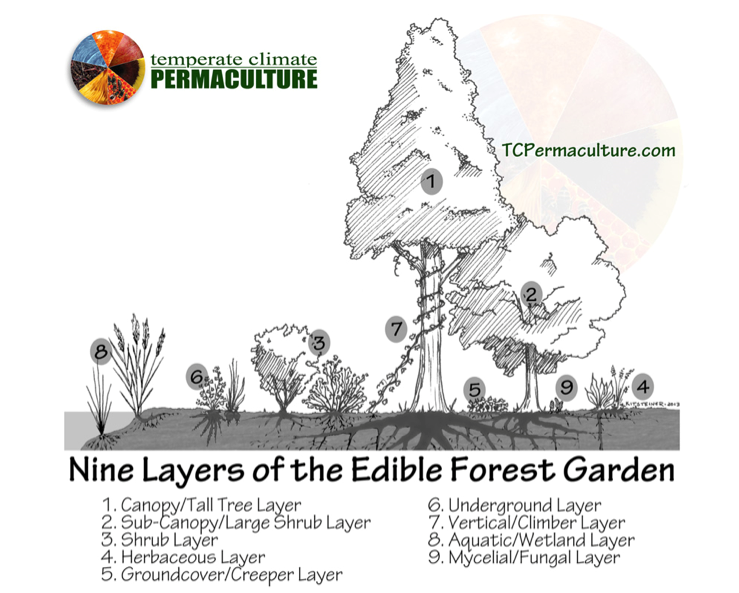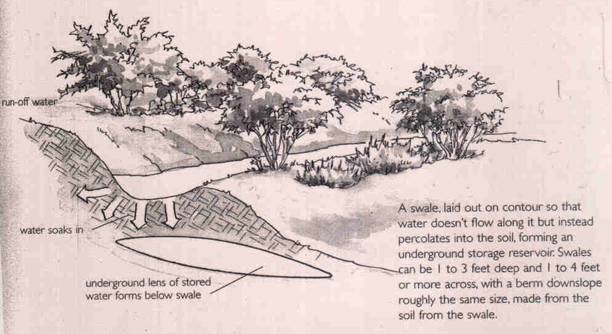Create your own Food Forest
Notes prepared by Scott Hitchins, 2025
The ‘Food Forest’ is a very popular concept in Permaculture gardening that attempts to recreate many of the functions of a natural forest but with the outputs, such as food and habitat, being aimed towards satisfying human needs. A natural forest doesn’t have a gardener come in and remove the weeds, plant seedlings, make compost and deal with insect pests. All these jobs are done by nature. In a Food Forest, we attempt to invite nature into our garden to do much of the work in a manner far more efficient and sustainable than what we could manage ourselves.

Some key concepts
As with a natural forest, our Food Forest is made up of many layers. Where we would traditionally envisage a space for just one lonely fruit tree, you would expect to develop, within the same space, a multi-layered productive eco system that supported and protected your fruit tree while providing you with several additional functions and harvests:
This multi-layering effect is usually shown as seven layers, but the above diagram adds in the two additional layers of 8) Aquatic /wetland and 9) Mycelial/Fungal layer, which is arguably part of layer 6). The following diagram provides an example where this concept has been applied to an apple tree, using compatible plants. This type of grouping is referred to as a ‘Guild’, in this case, an Apple Guild.
If we go through this diagram layer-by-layer, we can see that there are plenty of edible plants which are doing double or triple duty: The borage and bee balm (aka lemon balm) are attracting bees and predatory insects such as hoverflies while also providing edible leaves and flowers, ground cover to block weeds ad protect the soil, visual appeal, organic matter. The deep roots of the borage are also bringing minerals back up to the surface where, when the borage dies, they will become readily available to the apple tree’s shallow feeder roots. The Climber layer seems to be missing, but this could be covered by the legumes which are often seasonal climbers, such as peas and runner beans. As the tree becomes more mature, this layer could be added to by planting a grape to climb through the tree and add another harvest.

Everything has a job to do:
- In a suburban garden, the Canopy layer and the Lower tree layer tend to combine a little. This is mostly because, on this scale, fruit trees are best kept to a maximum height of 2-3 metres to ensure that you can pick, prune, net and inspect them easily while standing safely on the ground. You may have to deal with some larger established trees which you leave in place for sentimental reasons, or as habitat for wildlife, or due to local regulations, or just because they are doing a good job already. In this case, you need to consider what will grow under, around and through them, and perhaps do some minor pruning to let the sun in.
- Every tree and plant should perform a number of functions such as food, mulch, flowers, shade (winter, summer, or all year),support for other plants, insect attracting or repelling and many other functions. No plant will perform all of these, but select plants so meet a wide range of functions between them. You may also have particular needs in your garden that may include selecting plants for Weaving, Dyeing, Snail-farming, Pet-accommodating, Wild bird attracting, Sources of herbal remedies, Herbs for a particular cuisine, Home brewing, and many countless others. Include these in your plans from the start.
- Remember, unlike a commercial orchard, you don’t want hundreds of kilos of fruit from each tree: keeping the trees pruned smaller or narrower means that you can fit in more fruiting plants and get a large variety of fruits over a longer season instead of a glut of one thing.
Animals are another component of the Food forest that we need to consider. Right from the very start, we will be utilising small animals to help us establish our Food Forest: Worms to aerate the soil and take organic matter down below; slaters, earwigs, slug, snails and many other creatures to break down organic matter so that bacteria and fungi can finish the job; Bees, flies and others to pollinate flowers and hoverflies, ladybugs etc to turn munching pests into fertiliser. As the forest gets better established, we can benefit from visits by birds that eat bugs and snails while bringing in little deposits of fertiliser from around the neighbourhood (and sometimes sharing our crop as payment). We eventually get to a stage where we need to consider whether bringing-in chickens, rabbits, guinea pigs or other livestock can be of net benefit to the system. Chickens, in particular, can be very destructive to a backyard food forest and should only be introduce for short periods of intense work (such as cleaning out a patch of grass) or at very low stocking rates ( maybe one or two in a large established backyard Food Forest). Certainly, chickens can play a great role next to a food forest where plant waste, yummy snails and manures can be swapped back and forth.
Annuals vs. Perennials
Perennial plants are well suited to a Food Forest as their long lifespan minimises disturbance of soil biology and the roots of other plants. This includes such classics as asparagus, artichokes, jerusalem artichokes, rhubarb and sorrel, as well as many perennial herbs such as thyme, oregano, lemon balm, fennel and sage. Annuals also play a part but should be mostly comprised of easy self-seeding plants that will continue to reproduce without our intervention and where any excess ca be removed as an edible harvest, as chicken food or as a ‘chop and drop’ mulch.
Sun and Shade
Sunshine is the key to edible gardening: You can change the soil, provide water as extra ‘rainfall’ and protect the site from frosts and drying winds, but you must get at last 4 hours of sunlight a day to compensate for all the bits which you keep picking of your edible plants. Shade-loving plants such as the mints will produce with a bit less, but anything which you pick fruiting parts from will need the energy to renew itself. North-ish facing gardens will get sun for the longest (8-10 hours in summer), but all directions will get some sun. Given a choice, aim your garden to the North and then plant in layers to grab every last bit of sun and make it work hard for you.
Reflective surfaces, such as white-painted fences and walls are a good way to get some extra sunlight into those marginal spots.

Walls and other micro climates
Lack of gardening space driving you up the wall? –then drive your garden up the wall! -Espaliered fruit trees, vines on trellises, wall mounted pots and hanging baskets will all give you heaps of extra growing space within the same surface area. Not only that, but a sunny brick wall as the backdrop for your garden will soak up the heat during the day, enabling you to grow semi-tropical fruits and other frost sensitive perennials (Have you seen the bananas growing and fruiting at Maidstone Community Centre?)
Of course, if we can get warm microclimates, we can get cooler, shadier or frostier ones: These are the spots to plant semi-shade loving herbs and fruits such as Cape gooseberries, strawberries, blueberries and elderberries
Further Resources
Books
Gaia’s Garden -a guide to home-scale permaculture. Toby Hemenway. Chelsea Green Publishing company
How to Make a Forest Garden. Patrick Whitefield. Permanent Publications
Introduction to Permaculture. Bill Mollison. Tagari Publications
Permaculture in Pots. Juliet Kemp. Permanent Publications
The Wilderness Garden. Jackie French. Aird Books.
Perennial Vegetables. Eric Toesmeir. Chelsea Green Publishing company
Permaculture Plants. Jeff Nugent & Julia Boniface. Chelsea Green Publishing company
Facebook groups
Werribee Park Heritage Orchard
YouTube
Highly Productive Urban Farm / Sustainable Garden / Permaculture / Edible Beauty / Fruit and Veggies
Urban Permaculture with Geoff Lawton
Create Your Own FOOD FOREST in 3 Steps [How to Transform Any Piece of Land Quickly]
Legendary Australian Permaculture Garden Tour – David Holmgren and Su Dennett’s Melliodora


